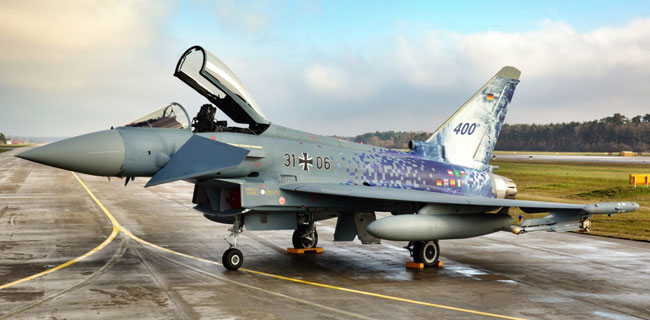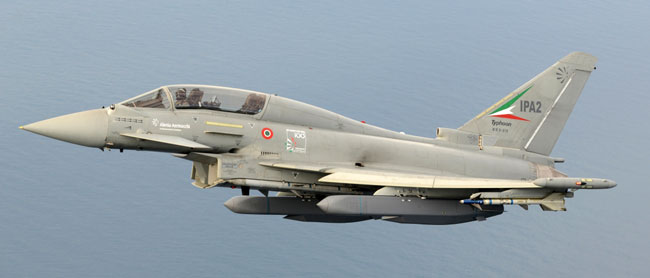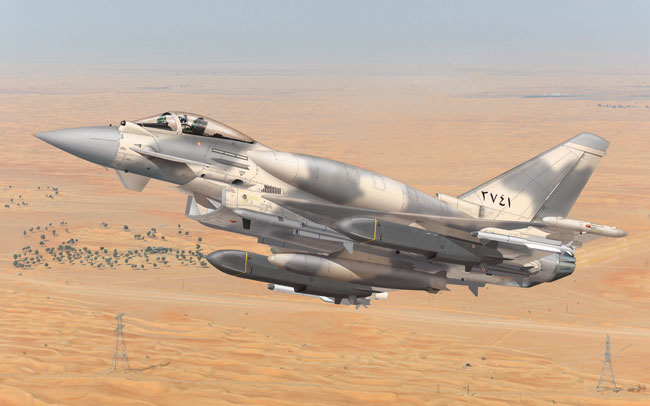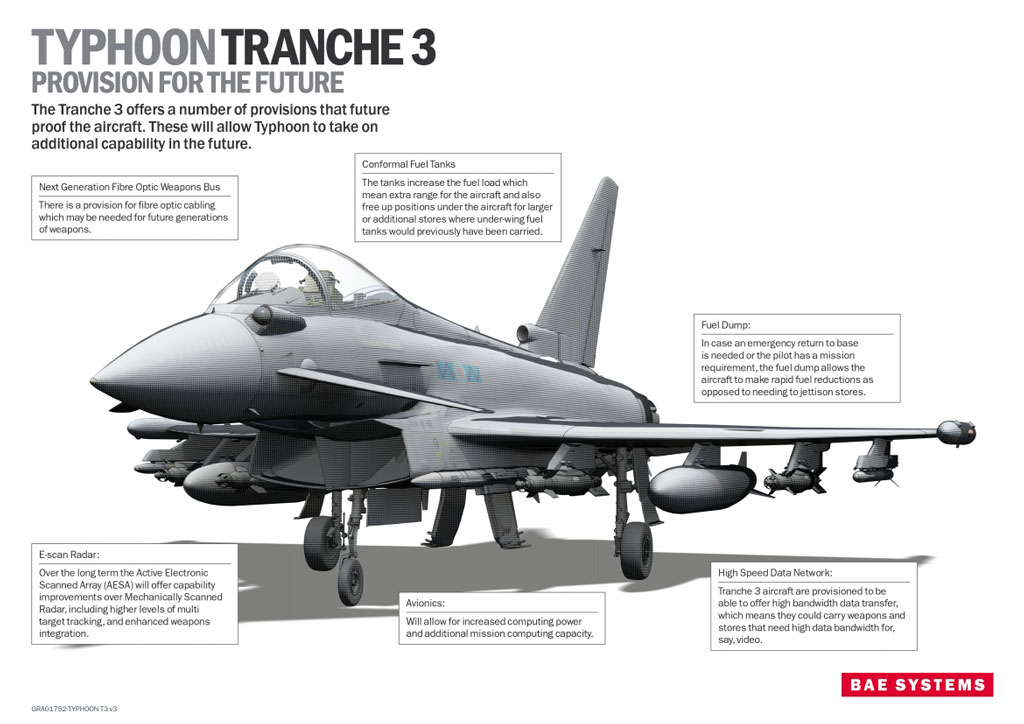
Cassidian, EADS’ military division soon to be transformed into Airbus Defense and Space) celebrated last week the delivery of the 400s Typhoons jet fighter to the customer – the German Luftwaffe. On December 4th the 400th Typhoon that received the marking ‘31+06’ at the company’s Military Air Systems Center at Manching, near Munich was the 112 Typhoon delivered to the German Air Force. With 719 aircraft under contract and 571 on order, Eurofighter Typhoon is currently the largest military procurement program in Europe. “We must focus much more strongly on export campaigns in order to win new contracts and new customers for this outstanding aircraft.” Stressed Alberto Gutierrez, Chief Executive Officer of Eurofighter Jagdflugzeug GmbH. At present, the Eurofighter Typhoon fleet comprises 20 operating units with locations in Europe, the South Atlantic and the Middle East.
In the past 10 years the global Eurofighter fleet has accumulated more than 210,000 flying hours and is expected to reach 250,000 flight hours by spring 2014. Specifically there are: 7 units in the UK (4 in Coningsby, 2 in Leuchars and 1 in Mount Pleasant, Falkland Islands); 5 in Italy (2 in Grosseto, 2 in Gioia del Colle, 1 in Trapani); 3 in Germany (Laage, Neuburg and Nörvenich), as well as 3 in Spain (2 in Morón, 1 in Albacete) and one each in Austria (Zeltweg) and Saudi Arabia. Oman will be become the eighth Typhoon operating center as it receives its delivery of 12 Typhoons in 2017.
Among the developments currently underway are about a hundred improvements enhancing the fighter’s strike capability under all weather is the upgrade cycle known as ‘Phase 1 Enhancement’ (PE1). P1E implements full Air-to-Surface capability on Eurofighter Typhoon – including the Litening 4 Laser Designating and Targeting Pod, integration of smart weapons, modern secure Identification Friend or Foe (IFF Mode 5), improved Radios and Direct Voice Input, Air-to-Surface Helmet Mounted Sight System, improved Air-to-Air capabilities including digital integration of Short Range Air-to-Air Missiles and updating the functionalities of Multifunctional Information Distribution System (MIDS) Datalink to enhance interoperability among Coalition Forces.
Other upgrades underway are the integration of the MBDA Meteor air-to-air missile; Storm Shadow and KEPD 350 standoff strike weapons and the new Captor-E Active Electronically Scanned Array (AESA) radar .

The first of a new standard of Typhoon has started its series of flight tests this month. “The latest Typhoon, known as a Tranche 3 embodies a number of under the skin changes that effectively future proof the aircraft and make it more attractive to current and potential export customers.” Said Mark Kane, BAE Systems Managing Director – Combat Air. “One of the few visual clues is a number of small panels on the fuselage which are there to accommodate the fitting of conformal fuel tanks. Once fitted, these would give the aircraft greater range and free up positions under the aircraft for larger or additional weapons. At the nose a new internal structure has been built and work has been carried out on power, cooling and electronics so that a new E-Scan radar could easily be accommodated.” Kane added.
In November the first in a major series of flight tests to integrate the MBDA Storm Shadow missile onto the aircraft took place. Earlier this year Eurofighter Typhoon announced a contract to develop the integration of the Meteor weapon system.
During the same period another development aircraft has been modified to take the CAPTOR-E (E-Scan) radar. It is currently being prepared, at Warton, ahead of its first flight. The upgrade of the radar to CAPTOR-E is expected to bring significant operational benefits, as the airframe allows the Typhoon to deliver a large electronically scanned array, increasing detection and tracking ranges, to support advanced Air-to-Air (Meteor) and Air-To-Surface capability with enhanced electronic protection measures. The large airframe also allows a wider field of regard, compared to other platforms. The new radar is being built by a consortium composed of Cassidian, Selex ES, and Indra. In November 2013 the new radar has entered the system integration phase at the Selex facility in Scotland, following the successful completion of the radar’s antenna array subsystem, a milestone reviewed by the four members of the Eurofighter consortium – Britain, Italy, Spain and Germany. Final integration of the radar into production aircraft is expected to start next spring. The new radar is expected to enter operational service by 2016.

Further planned upgrades include: laser warning systems, enhanced Defensive aids sub systems (DASS, conformal fuel tanks, thrust vectoring for greater maneuverability; advanced targeting pods; enhanced computing abilities; and passive missile warning systems. The introduction of two standoff weapons – the Storm Shadow and Taurus are of specific importance for the air forces operating the Tornado, expected to phase out of service by the turn of the decade.

[nonmember][/nonmember]The Storm Shadow and Taurus (KEPD-350), both are already in service with the Italian Air Force and Royal Air Force and German Air Force Tornados, are conventionally armed, stealthy, long-range standoff precision weapons designed to neutralize high value targets. These weapons systems will enable Typhoons to strike in day or night in all-weather conditions, engaging well-defended infrastructure targets such as port facilities, control centers, bunkers, missile sites, airfields and bridges that would otherwise require several aircraft and missions. The integration of Taurus will be particularly valuable for the Typhoon’s prospect in South Korea, where the new weapon was selected for the F-15K Slam Eagle and the follow-on strike fighter Seoul could be buying along with the F-35A, to replace the F-4E by 2017.
The Storm Shadow and Taurus could be introduced with Typhoon units from 2015, as the introduction of Typhoon Phase 2 Enhancements become operational. Under the Tranche 3A contract signed in 2009, a total of 112 aircraft have been ordered for the four European partner nations of Germany, Italy, Spain and the UK, with 40 aircraft bound for the Royal Air Force.
The UK MOD announced this week that the one of the oldest squadrons in the Royal Air Force is to be re-equipped with the latest Typhoon jets. The move is part of a transformation of the RAF’s combat air capability, which will see the battle proven, Tornado GR4 aircraft replaced by state-of-the-art Typhoon and F35B Lightning II fighters.


















